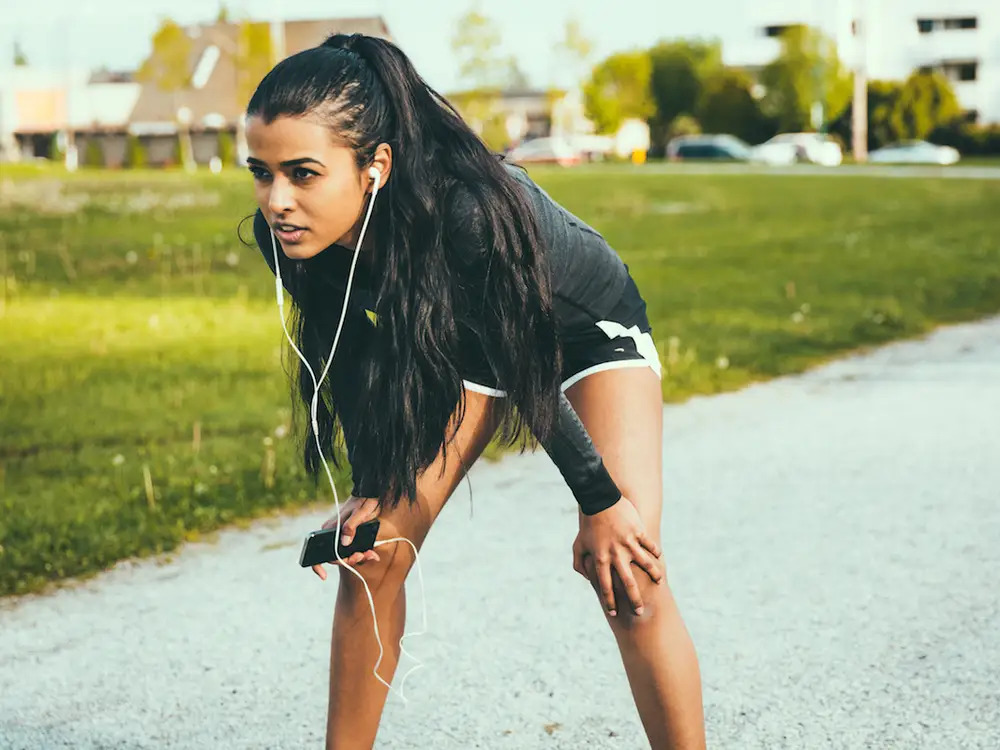If you’re looking to run your first 5K, you’ve come to the right place.
In today’s guide, Personal training Toronto will cover common questions – and 5 mistakes – about the Couch to 5K program:
- What is Couch to 5K? Why is the Couch to 5K plan so popular?
- Does Couch to 5K actually work?
- “Will I lose weight with Couch to 5K?” (Mistake #1)
- “Do I even like running?” (Mistake #2)
- “Am I healthy enough to run a 5K?” (Mistake #3)
- How to start (Couch to 5K Schedule and PDF)
- “How do I not hurt myself running a 5K?” (Mistake #4)
- 10 tips and tricks for running a 5K.
- “What do I do after Couch to 5K?” (Mistake #5)
- “What if I own a futon? Can I still do Couch to 5K?”
Before we jump in…
If you’re interested in running a 5k (which you are, ’cause you’re here), no guesswork needed, just tie your shoes and follow along with us.
What is Couch to 5K? Why is the Couch to 5K Plan so popular?
The Couch to 5K program is a complimentary initiative that guides individuals from a sedentary lifestyle to successfully completing a 5K race within a span of 9 weeks.
A 5K race covers a distance of 5 kilometers, equivalent to 5,000 meters or approximately 3.1 miles.
This running regimen was pioneered by Josh Clark of CoolRunning quite some time ago. Since then, it has been adopted and replicated by numerous running enthusiasts and blogs. Therefore, we commonly refer to it as a general “Couch to 5K” program.
When individuals inquire about the duration to complete the Couch to 5K program, the timeline can vary based on the specific version of the program they opt for. It might range from 6 weeks to 12 weeks. The initial Couch to 5K plan introduced by CoolRunning was structured over a period of 9 weeks.
Here’s a succinct overview of the Couch to 5K plan:
The program employs the popular technique of interval training, involving varied speeds during each running session. It provides a detailed daily plan for 6-12 weeks after initiation.

By alternating your pace, your body is compelled to adjust to different speeds, leading to improvements in cardiovascular endurance and overall fitness.
As a result, more calories are burned, and participants become better prepared for the race compared to training at a consistent speed.
In essence, interval training is highly effective and recommended for anyone aiming to enhance their running abilities.
Throughout the program, Couch to 5K gradually increases the duration of running and reduces walking intervals until participants reach a point where they can run a 5K without interruptions.

WHAT MAKES COUCH TO 5K SO INCREDIBLY POPULAR?”
1) IT’S STRAIGHTFORWARD AND EASY TO FOLLOW.
Whether you print a PDF or use a handy iPhone app, the Couch to 5K plan provides clear instructions for the next 9 weeks:
- Today, this is your task.
- Tomorrow, tackle that.
- Repeat.
We’re all leading busy lives, often feeling swamped. Programs that lay out precise instructions alleviate the need for us to figure things out on our own. Not that we, as enthusiasts, tend to overanalyze things to the point of inducing anxiety…
2) RUNNING IS COMMONLY LINKED WITH WEIGHT LOSS.
For those who are new to the realm of health and fitness and aiming for weight loss, the starting point and how to begin can be overwhelming.
Will you opt for a gym membership, hire a personal trainer, and dive straight into squats and deadlifts? While I wish that could be the immediate solution (as it’s likely the quickest way to transform one’s physique), it’s often a daunting leap for many.
Hence, many beginners associate running with weight loss (which could be true, but not always – I’ll elaborate here) and decide to start with a light jog around the block.
3) COUCH TO 5K IS NOT INTIMIDATING.
It’s a cost-free program (or a budget-friendly app) and very approachable.
Regimens like P90X and Insanity are tailored for those who perceive themselves as hardcore (whatever that may mean).
Couch to 5K resonates with individuals who find the thought of doing P90X, Insanity, or even summoning the courage to step into a CrossFit gym overwhelming.
Couch to 5K plants the seed of “maybe I can actually do this…” in your mind – the crucial first step in any fitness journey: commencing.
4) EVERYONE ASPIRES TO “COMPLETE A 5K.”
For those venturing into health and fitness and setting realistic goals, aiming to “run a 5K this year” is an excellent starting point.
- It’s a manageable distance that, with some training, can be achieved, even if walking is required for parts of it.
- There’s a multitude of 5Ks almost every weekend, often tied to charitable causes or themed in a fun way.
- Participating in a 5K is a fantastic group activity with friends.
- Human beings are wired to seek achievements, progress, and satisfaction – 5Ks align perfectly with these aspirations.
By completing Couch to 5K, you follow a structured training regimen, witness weekly progress, achieve the race finish line with a sense of triumph, and return home with a well-deserved medal as a reminder of that proud moment.
Furthermore, it might just kickstart your journey to improved fitness!
Perhaps… we’ll delve into this in a moment.
If your goal is to enhance your fitness, I’d like to introduce our 1-on-1 Online Coaching Program. I can think of no better way to transform yourself than under the guidance of an expert who knows precisely what steps to take. We’ve guided numerous individuals through their first 5K and supported others in preparing for triathlons!
Does Couch to 5K actually work? Will I lose weight Doing Couch to 5K?
What do you REALLY think about running 5Ks and Couch to 5K?”
Okay, you got me. I got thoughts. I also got jokes (they’re bad).
Will the Couch to 5K program help you run a 5k? YES! If you actually stick with it for the entirety of the training program.
Will the Couch to 5K program help you lose weight? MAYBE.
Is Couch to 5K a program that will get you healthy permanently? MAYBE.
Will Couch to 5K make me sexy and look damn good in a bathing suit? MAYBE, but probably not.
Here’s the truth about Couch to 5K: It’s the same truth with popular programs like P90X or Insanity or any other structured workout program:
It totally works and will help you lose weight if you do two things:
- You actually complete the program, AND
- You fix your diet.
As sexy as it is to think that just going for a run will help you lose weight, the data doesn’t back it up. In fact, as Time Magazine rightly pointed out years ago and got yelled at for telling the truth, exercise alone won’t make you lose weight.
I believe that to be especially true when exercise is only steady-speed cardio.

In fact, many people gain weight after starting an exercise routine and get completely demoralized.
What gives?
If you go for a mile run and then stuff your face with extra calories “because you earned it,” you’re going to gain weight.
It’s not because you have a slow metabolism, I promise. It’s because you’re consuming too many calories.
This is Common Mistake #1: not fixing your nutrition if you’re running for weight loss!
If this were a movie, nutrition would be Tom Cruise in Mission: Impossible and exercise is that funny sidekick who helps Tom. Let’s be real here, Tom is doing all of the heavy lifting to make that movie what it is.

Couch to 5K helps people run a 5K.
That’s it.
It’s not designed to help you lose weight or build a body you’re proud of. It’s also a temporary program that lasts a certain number of weeks until you run your 5K.
For Couch to 5K to be successful for you long term, and for it to help you lose weight, it needs to be the catalyst that causes you to build a consistent long term habit of exercise and changes how you think about food.
Remember: you never get to be “done”, so you need to enjoy the journey and look forward to exercising daily.
You also need to train the right way to build the type of body you want! And eat the right way.
That’s priority numero uno.
I know nutrition is a really challenging, complex, controversial topic (Keto? Paleo? Ah!), which is why we make it stupidly simple for smart, good looking, modest people like yourself.
Do I Even Like Running?

Bodybuilder Ronnie Coleman summed it up perfectly:
In essence: “Everyone desires to be in excellent shape and look fantastic, but not many are willing to put in the effort to truly achieve that level of fitness and appearance.”
And indeed, achieving a great physique is challenging; if it were easy, we’d all resemble Captain America or Wonder Woman.
Instead, a significant 70% of America grapples with being overweight, with over 30% classified as obese. A disheartening reality.
This leads me to the pivotal question regarding the entire 5K journey:
Do you genuinely enjoy running?
The population can be divided into three categories:
- Those who enjoy running and aspire to run.
- Those who initially dislike running but eventually grow to appreciate it.
- Those who don’t like running and may never develop a liking for it.
Applying Ronnie Coleman’s perspective, slightly modified: “Everyone wishes to have completed a 5K, but a considerable number don’t derive joy from running.”
Running a 5K is a remarkable accomplishment and an enjoyable goal, but it’s just one of numerous methods to “get in shape.”
Many individuals resonate with Andy Dwyer from Parks and Rec when they attempt running.
Some revel in the feeling of pushing their limits or enduring the struggle, and that’s fantastic!
Yet, for others, they fall into Mistake #2: they compel themselves to run despite not enjoying it!
So, before embarking on the Couch to 5K program, view it as a scientific experiment:
“I posit that following Couch to 5K will aid me in completing a 5K. I also posit that I’ll find joy in the process, in how I feel after a run, in running a 5K, and/or in the accomplishment of having completed a 5K.”
And that’s precisely what this is: an experiment to determine if running aligns with the type of exercise you wish to consistently engage in over the coming years.
If, two weeks into Couch to 5K, you’re miserable and loathe it: excellent!
You’ve just realized that running isn’t your cup of tea, and you’re now free to steer clear of it forever. It doesn’t label you a failure.
It simply means your experiment has yielded a result, which you can utilize to guide your future exercise choices.
Once more, it doesn’t signify failure.
It signifies discovering a form of exercise that isn’t suitable for you.
If you discover a genuine passion for running and the positive impact it has on you: fantastic! You can now incorporate running into your regular workout routine. Combine this with a sound nutritional plan, and you’ll sculpt a runner’s physique. You’ve found an activity for a lifetime.
If you’re running to prove something to yourself, because a friend is doing it, to support a charitable cause, or any other reason: excellent! Complete Couch to 5K and then evaluate if this is the approach you enjoy and want to commit to permanently.
Avoid Mistake #2: If your sole motivation is weight loss, and running is making you unhappy, reconsider. Don’t force yourself to run. Ever.
Instead, select an exercise you genuinely relish. Not because it will aid in weight loss, but because engaging in an exercise you love serves as a constant reminder that “I’m making healthier choices, and thus I should probably eat healthier!”
If weight loss is your primary objective, I recommend our Beginner Bodyweight routine, which can be performed at home, coupled with our “Beginner’s Guide to Healthy Eating.” I can assure you that by adopting these strategies and incorporating them into your routine, you’ll witness progress without ever stepping foot on a treadmill.
Whew! That covers the crucial question of “do you genuinely enjoy running?”
There’s another significant question you should ponder before commencing.
Are You Healthy Enough to Run a 5K?
Just because you WANT to run doesn’t mean you SHOULD necessarily start running just yet.
It could be a fast track to injury, disappointment, and misery!
Those are literally three of my least favorite things. The fourth being brunch.
Back to your health: are you physically ready to run?
If you’re at or close to your goal weight, then starting a running program is a good idea.
Read the section below on “How to not get injured doing Couch to 5K” and get started.
If you are obese or very overweight, I think (power) WALKING a 5K is a great goal for the immediate future.
However, I think Mistake #3 would be running a 5K before properly preparing your body for it! In fact, running prematurely without addressing your weight might cause damage to your joints and ligaments and cause you to backslide a whole bunch.
WHAT I WOULD DO INSTEAD: Focus on healthy eating, build the habit of daily walks, and following a beginner strength-building routine like the Beginner Bodyweight Circuit.
This will build you a solid foundation of strength, core strength, and endurance.
Here’s why you should focus on strength and nutrition before pounding the pavement with hours of running:
- As you begin to drop weight, a lot of the stress on your joints, organs, bones, etc. will start to decrease.
- As you strength train, the ligaments that hold your body together will become stronger and more adequately prepared for the rigors of running.
- As you refine your running form to minimize resistance and jarring shocks throughout your body, your body will learn to become more efficient.
- When you start to approach your goal weight, you can start to increase your speed from power walking to jogging – with correct running technique (see below) – and staying healthy.
“I was all excited to run a 5k, and now you have me demoralized. I’m overweight but I still want to run!”
Okay okay okay, fine! I don’t want to keep you from exercising, I want to help you build momentum and make you antifragile.

Obviously, you’re going to do what you’re going to do, and if running before you’re physically ready is what you want to do, go for it!
Just do it safely, please! Read the section below on proper running technique!
I would still advise that you focus your efforts on strength training, hiking, long walks on the beach…low impact activities that strengthen rather than deteriorate your body.
But you do you, boo.
If you want any help getting in shape to run your 5K, we got you! We help men and women and self-aware robots with our 1-on-1 Online Coaching Program. We offer nutritional guidance, professional accountability, and custom workouts!
How to Start the Couch to 5K Program
I read all of that jazz above and I am ready to get started. Whether I’m walking or running, I want to start Couch to 5K!”
If you’re ready to do the Couch to 5K program, you can download the following which I believe is the Original Couch to 5K Program (they’ve made it quite tough to find!).
The reason it’s tough to find is they’re pushing people towards the official Couch to 5K App.
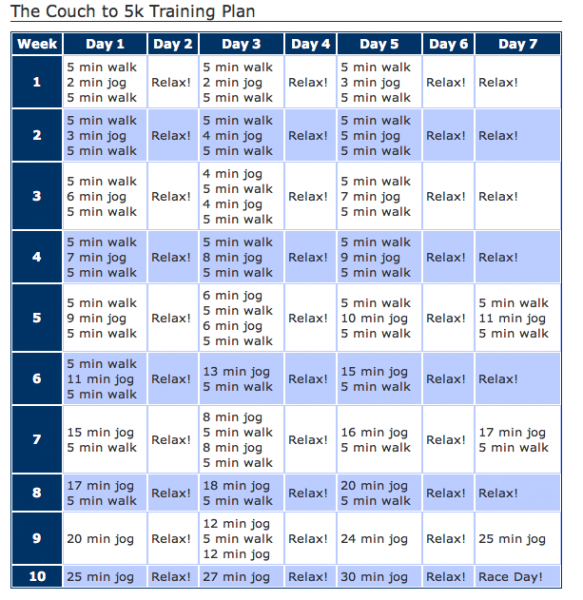
Here’s another which I found:
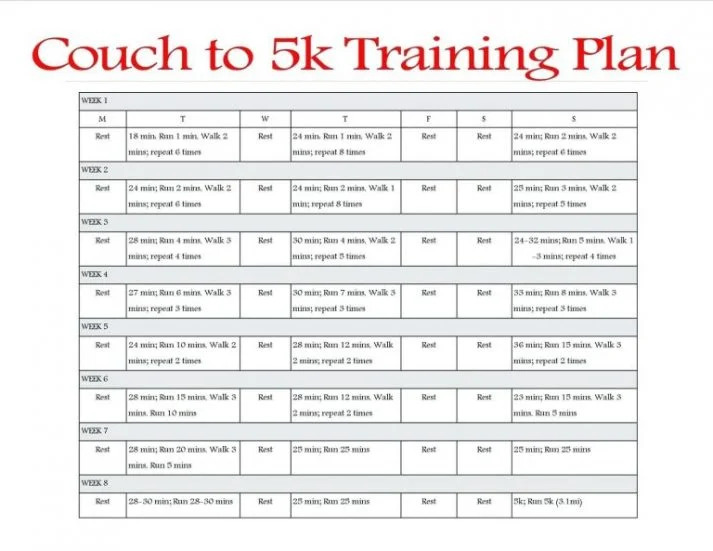
For us Nerds, I’d be remiss if I didn’t mention the super fun Zombies Run! app, which uses interval training combined with fun audio cues and video game mechanics throughout your running sessions.
What I would do next after downloading the program? Do the first day of training!
I would also recommend finding a race that’s 2-3 months from now, and sign up for it even if you’re not ready.
Recruit a friend or two to join you in training and the race!
Doing these things create immediate motivation and accountability.
HOW TO FIND A 5K IN YOUR TOWN: Let me google that for you. Type “5K + [your town]”, and I bet there’s a 5k every weekend for the rest of the year coming up. The Couch to 5K app also lists local races for you.
To recap:
- Pick a race that looks fun that raises money for a good cause
- Recruit a friend or two
- Go for your first day of running!
It’s gonna suck, and you’re going to be fine. You’ll get better!
How to Not Get Injured Training For a 5K

If you fail to grasp the proper running technique, you’re setting yourself up for potential overuse injuries, essentially undermining the very reason you took up running!
This leads us to Mistake #4: Inadequate Running Form!
When you run, each bounding step on the road exerts immense pressure, amounting to hundreds of pounds, on your joints and ligaments.
Consider that this is repeated thousands of times during training and races.
No wonder almost every runner has a plethora of injury tales. Running can be a grueling activity, even with good running mechanics.
Poor running mechanics only exacerbate the consequences.

Not the kind of “compounded” that’s beneficial, akin to compound interest you learned about in 2nd grade, where you start with a penny and double it every day for 30 days.
Instead, it’s the detrimental kind of “compounded,” leading to issues like plantar fasciitis, stress fractures, sore IT bands, torn ligaments, and persistent soreness.
We definitely want to avoid that.
In this section, I’ll delve deeply into proper running technique. If you already possess impeccable running form, you might consider skipping this section, although I’d still recommend giving it a read.
Yeah, you should probably read it.
Here are the “5 Steps to Enhance Your Running for a 5K”:
1) LEAN FROM YOUR ANKLES
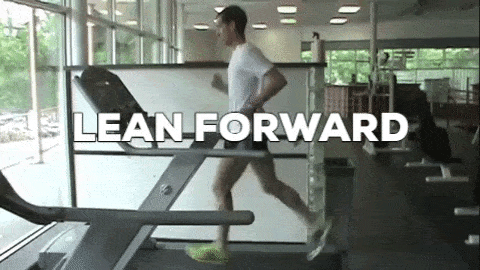
Initiate a slight forward lean from your ankles, maintaining a straight line from your ankle through your butt and up to your head.
When stationary with this gentle lean, you should feel as if you’re on the verge of moving forward.
Once you start running, gravity will assist your forward momentum. An appropriate lean from the ankles keeps your body aligned and ensures efficient and effective muscle engagement.
2) INCREASE YOUR CADENCE
Cadence refers to your stride rate, or the number of steps you take per minute. Initially, this may feel unusual, but shorter foot strikes reduce stress on your legs.
Aim for a cadence of at least 170-190 steps per minute during a comfortable, conversational pace. As you run faster, your cadence will likely increase – that’s perfectly normal.
Wondering what to do with “170-190 steps per minute”?
Excellent question. Head over to Spotify and search for playlists with 170-190 beats per minute (BPM)
Not a Spotify user? No worries. (But seriously, why not?) To determine your cadence, try running to Outkast’s “Hey Ya” and synchronize your strides with the beat. That’s the cadence you’re aiming for.
Research has demonstrated that increasing your cadence to about 180 steps per minute provides similar benefits to barefoot running: reduced impact shock, enhanced running efficiency (meaning you’ll run faster with less effort), and a lower risk of injury.
You might feel like you’re taking more steps than usual, indicating you likely had poor form before and are now correcting it!
If your legs start moving at this pace, let me know.

3) FOOT STRIKE AT THE RIGHT TIME
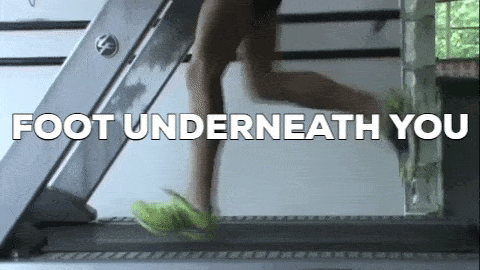
Ensure that when your foot makes contact with the ground, it’s beneath your body, not in front of it.
By combining a swift cadence, a slight forward lean from the ankles, and a correct foot strike, you’ll evenly distribute and efficiently manage the impact shock.
Beginning runners often overlook this aspect of running form. Instead of focusing on where the foot lands relative to the body, they place excessive emphasis on running on their forefoot. However, without landing in the right position, a midfoot or forefoot strike can cause more harm.
Visualize that you’re simply “placing your foot down” in a straight line underneath your body as you run. Avoid reaching or extending your leg forward. Practicing this mental cue will ensure your leg lands almost directly under your center of mass, evenly distributing your weight and maintaining safety.
4) LAND ON YOUR MID-FOOT
While not as crucial as landing under your center of mass, adopting a mid-foot strike offers numerous advantages.
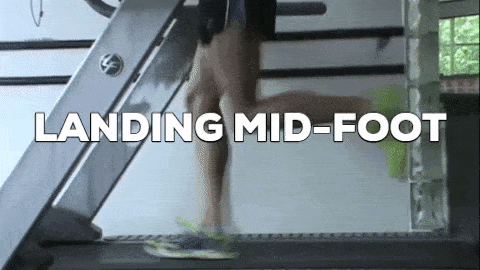
It can help you steer clear of many injuries by absorbing impact shock and preventing an aggressive heel-striking stride.
While heel striking isn’t entirely to blame for injuries and shouldn’t be labeled “bad,” becoming a mid-foot striker can be immensely beneficial. It allows for better shock absorption and helps avoid a severe heel-strike running style.
Even elite athletes occasionally heel strike during races. It’s not entirely negative, especially if you shift your weight to your foot just after the heel strike, rather than directly on the heel.
5) SYMMETRICAL ARM SWING
An optimal arm swing involves maintaining a 90-degree bend in your arms and swinging them in a front-to-back motion, avoiding any side-to-side movement. Visualize an imaginary line down your mid-line or body center. Your hands, while running, should not cross over this imagined line.
Gently cup your hands together (avoid clenching fists) and, if you wish to utilize your arms for momentum, focus on pumping your elbows rather than your hands.
Once you integrate these adjustments into your running technique, you’ll experience increased comfort, and the risk of injury will significantly decrease.
For an added positive measure, aim to run with a soft and quiet footfall. Avoid heavy foot stomping, which becomes more challenging as you approach a cadence of 180 steps per minute.
Here are a few more key considerations to maintain good running form:
- Maintain Proper Posture: Keep your back tall and your chest up. Avoid slouching, as maintaining an upright posture is crucial for good running form.
- Focus Ahead: Look 30-50 meters in front of you, avoiding the habit of looking down at your toes. This encourages an athletic posture and supports good running form.
Both of these guidelines are simple yet effective cues to help sustain an athletic posture and ensure you maintain good form while running.
Feel free to revisit this section several times. We understand that there’s a lot to think about while running, but these aspects are immensely important. If possible, record a video of yourself running and review it to assess your form.
It’s worth mentioning that we offer form checks to our coaching clients. Through our user-friendly app, you can record a video of your running form or exercise technique and send it directly to your coach. This way, you can ensure that you’re running and training in a safe and correct manner!
10 Tips and Tricks for Training for Your 5K
Although the Couch to 5K Program covers specifically how you should be training, it still leaves out quite a few important things (like technique, which I covered above!).
Once you’ve picked your 5K training program, here’s how to get yourself to ACTUALLY follow through on your training!
1) Recruit an accountability partner. Have somebody that trains with you (or at least somebody you tell about your training), so that each day you can check in with each other.
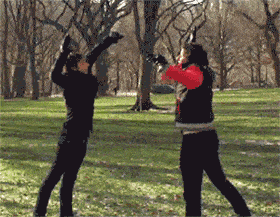
Wanna be diabolical?
Give somebody else $100 of your money. And tell them you’ll check in with them after your training every day – if you don’t do your run, they’ll donate $50 of that money to a political cause you HATE.
While you’re building the habit of running, you need to make the pain of skipping your run greater than the pain of doing the run.
Do this enough times until you build up enough momentum and get hooked on that runners high so that you actually look forward to training.
2) Warm-up before, stretch after. Don’t do static stretches before your runs. It’s not doing what you think it is. Instead, you’re going to warm up your muscles through active movement.
- Do a dynamic warm-up before you run. Continue this by going for a light jog, high knees, and warming up your muscles through movement.
- Do the following cool-down stretching routine after you run. Stretching after for the win!
3) Make it the first thing you do each day. Build the habit of doing your run first thing in the morning when life hasn’t had a chance to get in the way.
Sleep in your running clothes.
Put your alarm clock/phone across the room. Put your running shoes by the door. By hacking your Batcave, you’ll minimize the steps between you and the new habit you’re trying to build.
4) Strength training makes running easier. Doing 1-2 sessions of strength training per week (on days you’re not running) will help you burn fat, build muscle, and stay injury-free.
5) Don’t worry about your shoes when you start. Wear whatever shoes you have so that you can just get started building the habit immediately. If you START to love running, read our article on proper footwear and get yourself some better kicks.
The same is true for “running clothes.” Do not let this be a barrier to entry.
Start running first and make sure you like it before you go spending any hard-earned cash on stuff you’re not gonna use.
6) Sign up for your race as far in advance as possible. Use 20 seconds of courage if you need to, but commit to the race.
If you don’t sign up, you’re going to be much more likely to back out when life gets busy.
But if you pay for it ahead of time, and get other people to run with you, you’re going to be using positive peer pressure to follow through on your commitments.
7) Your race time doesn’t matter! Who cares if you’re the last person to finish? Like the Rock taught us, it doesn’t matter.

What’s important is that you finish something that you started. That’s a huge accomplishment in itself.
8) Start a running club or join one at work – the more people you surround yourself with that are doing the things you want to do, the better. Hang out with runners that are faster than you.
You’re the average of the 5 people you associate most with, so you might as well start associating with faster, healthy runners.
9) Don’t have an in-person running community? That’s cool! Join the Scouts Guild in the Nerd Fitness Rebellion.
It’s the section of our community that does running, biking, swimming, and other distance-based activities!
10) Hire a coach. Outside of having a group of friends or co-workers keeping you accountable, a coach who routinely checks in with you and your progress can be a godsend. We’ve helped tons of people build the habit of running!
What Do I do After the Couch to 5k?
Congratulations on successfully completing your training and crossing the finish line of your first 5K! I am genuinely thrilled for your accomplishment.
Gold star for you!
A+.
Now that you’ve accomplished this milestone, you might be contemplating what step to take next. Should you continue running or take a break?
For many new runners, the race environment is incredibly appealing—the adrenaline of number pick-up, the motivational pre-race speeches, the enthusiastic crowds, and that incredible feeling as you cross the finish line.
Oh, and let’s not forget the post-race beer and meal, often tasting like the best food and drink you’ve ever had.
Once the excitement settles, it’s important to consider your next move.
You have three primary options:
- Run Faster: You can sign up for another 5K, persist with your training, and aim to surpass your previous race time.
- Run Longer: If you’re up for a challenge, you might want to extend your distance to a 5-miler, a 10K, or even venture into the realm of half-marathons or marathons.
- Explore a Different Activity: Transitioning from Couch to 5K only to return to a sedentary lifestyle isn’t beneficial. Temporary changes yield temporary results. It’s important to choose another activity and keep moving.
Notice that there isn’t a fourth option, which is typically the choice most people make:
“Go back to sitting on the couch.”
This leads us to Mistake #5: failing to have a plan for CONTINUING exercise after Couch to 5K!
As we emphasize at Personal training Toronto: “Temporary changes create temporary results.”
So, you must decide on the next step; otherwise, all the hard work and training you put in will go to waste!
Need assistance in determining exactly what path to take from here? I’m here to guide you!

